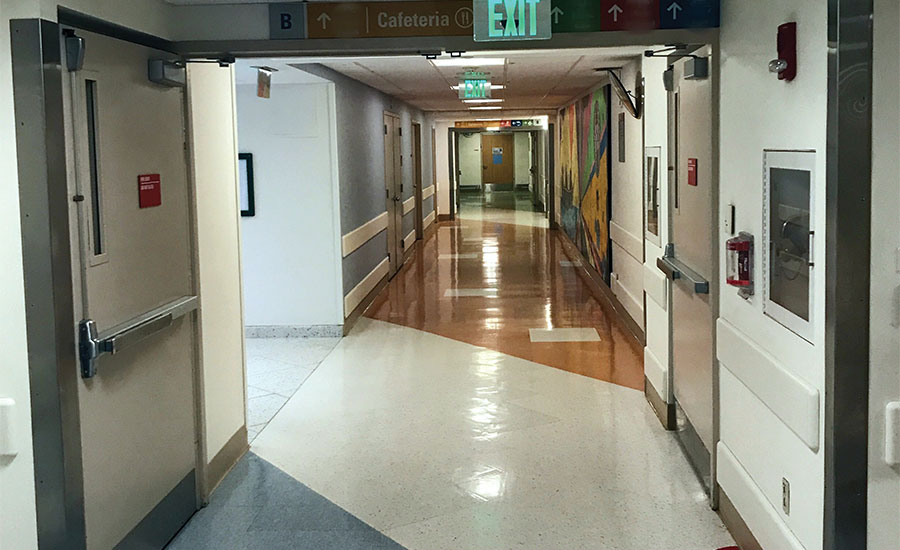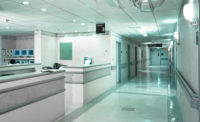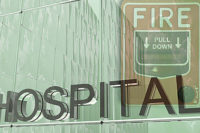Commissioning (Cx) certain building systems has been occurring for years, and the process is continually evolving. Commissioning is heavily driven by the need to achieve, validate, and document the complex designs of today’s building systems that emphasize system integration in order to achieve sustainability and efficiency goals. Specifically, there has been a rise in the commissioning of fire protection and life safety systems — not for utility savings, but for owners that want to confirm the fire protection and life safety systems are designed and installed to meet the overall project goals, comply with applicable codes, and provide protection to the building occupants, the building, and its contents.
Fire protection and Life Safety Systems in Health Care Facilities
Health care facilities provide unique design challenges as they are outfitted with fire protection and life safety systems that exceed those of a typical building. These systems are required in health care facilities based on the higher risk associated with the nature of the occupants, who are generally presumed to be incapable of self-preservation.
Health care facilities with occupancy categories such as ambulatory health care deploy a defend-in-place occupant protection strategy to deal with the higher level of risk amongst occupants. NFPA 99: Health Care Facilities Code defines the defend-in-place strategy as “The operational response to an emergency in a building, in which the initial action does not involve evacuation of the building occupants.” In other words, during an emergency or dangerous condition, the facility relies upon both passive construction and the active fire protection and life safety systems to compartmentalize the floor to direct the relocation of occupants and patients from an area of immediate danger to a safe location on the floor.
NFPA 101 establishes the following principles to execute the life safety goals in health care facilities:
-
Fire-resistance rated and smoke-tight construction
-
Smoke barrier compartmentation
-
Protection of vertical openings
-
Means of egress utilizing horizontal exits or interior stairs
-
Provision of exit marking, exit illumination, and emergency power
-
Interior finish material limitations
-
Fire alarm detection and notification
-
Smoke control systems
-
Protection of hazardous areas
-
Control of fuel loads
-
Operational features (no smoking, staff training, building system maintenance and testing)
-
Security
-
Adequate protection of building service equipment
To execute these principles, there are increased code requirements for the fire protection and life safety systems within a health care facility. For example, under current code, evacuation of a fully sprinklered high-rise office building is fairly simple, as the occupants egress to the fire resistance-rated pressurized stairs to exit the building. In this simple example, the typical building occupant will not travel through any other fire rated walls, except to enter the stair enclosure. However, commissioning this “simple” smoke control stair pressurization system is not so straightforward. Proper commissioning of the stair pressurization system requires integration of the sprinkler system, fire alarm system, emergency power, HVAC (in some instances), fire pump, passive construction (stair enclosure and doors), BMS (in some cases), and the stair pressurization equipment itself. This simple example quickly becomes compounded with multiple buildings systems that must work not only as independent systems, but reliably as a whole under various scenarios.
If the same fully sprinklered high-rise building includes a health care occupancy, then in addition to the high-rise smoke control system for the office buidling (i.e. stair pressurization), passive compartmentalized construction is required. This passive construction comprises fire-rated doors and fire/smoke dampers that close upon fire alarm to minimize the number of occupants exposed to the emergency situation and allow for the horizontal evacuation of occupants to a safe area of refuge on the same floor. On the mechanical side, pressure relationships must be maintained upon the loss of normal power in certain clinical spaces, such as airborne infection isolation rooms, critical care units, burn units, surgery rooms, and spaces with infection control and cross-contamination issues.
The health care industry is one of the most regulated. Code compliance is subject to numerous laws for health care operations, local municipal codes, and federal programs such as the Centers for Medicare & Medicaid Services (CMS). As such, health care facilities are often subject to inspection from multiple authorities having jurisdiction (AHJ’s), whom enforce a broad range of code requirements making code compliance a challenging task.
Modern health care facilities require various building systems across multiple disciplines to operate in a particular manner to achieve the desired outcome. For fire protection and life safety systems, the process to ensure that these systems (active and passive) operate as intended includes both commissioning and integrated testing, as documented in NFPA 3: Recommended Practice for Commissioning of Fire Protection and Life Safety Systems and NFPA 4: Standard for Integrated Fire Protection and Life Safety System Testing.
NFPA 3 and NFPA 4
Commissioning and integrated testing are two different concepts. As defined by NFPA 3, commissioning is “a systematic process that provides documented confirmation that building systems function according to the intended design criteria set forth in the project documents and satisfy the owner’s operational needs, including compliance with applicable laws, regulations, codes, and standards.”
Commissioning of fire protection and life safety systems occurs in the planning phase, design phase, construction phase, and occupancy phase. NFPA 3 also addresses commissioning of existing systems that have not been commissioned previously (retrocommissioning; ReCx) and commissioning of existing systems that have previously been commissioned (recommissioning; RCx).
Commissioning has historically been confused by many as acceptance testing with the authority having jurisdiction (AHJ). Commissioning is not just testing at the end of the project to determine if the fire protection systems are performing properly. Proper commissioning of systems includes the review of the design teams’ design documents, attendance at coordination meetings, review of shop drawing submittals, review of installation progress, review of contractors’ pretest documents, and witnesses the systems’ performance in accordance with the commissioning test plan.
Commissioning reports document the systems and their functionality. The commissioning of fire protection and life safety systems provide the owner with ease of mind knowing that these essential systems work as intended.
NFPA 3 defines a process for commissioning, but does not specifically detail how to test a particular fire protection or life safety system. Other NFPA standards provide information on how to functionally test specific fire protection and life safety systems, such as NFPA 72: National Fire Alarm and Signaling Code for fire alarm systems.
A commissioning authority (CxA) plans, coordinates, and oversees the entire commissioning process for all of the commissioned systems. A fire commissioning authority (FCxA) plans, coordinates, and oversees the commissioning process for all of the individual fire and life safety systems, both passive and active systems. A qualified FCxA has an advanced knowledge of and experience with the installation and operation of the fire and life safety building system(s) being commissioned. The FCxA may also be referred to as a smoke control special inspector in the International Building Code, which requires a qualified commissioning agent for smoke control systems.
The FCxA does not necessarily evaluate interaction between systems, such as in the case of the sprinkler system. The 2015 edition of NFPA 4 establishes that the fire protection and life safety systems be tested holistically to ensure that all systems operate together as a whole to achieve overall fire protection and life safety objectives.
As defined by NFPA 3 and 4, an integrated systems test is “a test performed on fire protection and life safety systems to confirm that operation, interaction, and coordination of multiple individual systems perform their intended function.” The integrated testing agent (ITa) implements and leads the integrated testing of the fire protection and life safety systems and their associated subsystems to verify the proper interface and coordination between various fire protection and life safety systems.
A qualified ITa also has an advanced knowledge of and experience with the installation, operation, and interfaces between the various fire protection and life safety systems being interconnected to each other. For example, fire alarm systems typically have different types of integration with other fire protection and life safety systems, such as sprinkler systems, smoke control systems, special suppression systems, elevator controls, fan controls, card-access systems, smoke dampers, and emergency generators. The same person can serve as both the FCxA and the ITa for a project, as long as they meet the qualifications for both positions.
Commissioning and Integrated Testing in Health Care Facilities
Fire protection and life safety systems must be reliable and must be able to perform their desired function based on various scenarios. Commissioning and integrated testing provides owners with added confidence via a third party that the fire protection and life safety systems are designed and installed properly. In some cases lack of commissioning and integrated testing can result in the system not being properly tested even with the local authority signing off on the system, which can then result in a system or program having issues or deficiencies that remain as part of the “approved system” in an occupied building.
The commissioning process verifies that the proper steps are being followed and that these systems work properly under various conditions/scenarios prior to new buildings obtaining their certificate of occupancy (CO). A properly commissioned system has been debugged, coordinated, tested, and documented so that all features of the overall system perform seamlessly. This typically makes the final acceptance test with the local building and fire departments much easier, since the systems function as designed/intended. Many owners and local jurisdictions see the direct correlation between a properly commissioned fire protection and life safety system and the reduction or elimination of their punchlist items and retests of those systems with the local building and/or fire departments.
Due to the fact that the fire protection and life safety systems are often the final systems to be tested as part of the certificate of occupancy process, they are also often the cause of costly delays in allowing a building to be opened and occupied on schedule. Such delays are costly in any building but especially for a health care facility.
Commissioning and integrated testing of fire protection and life safety systems continues to rise as buildings become more complex and the benefits (cost savings) of the commissioning and integrated testing process are realized. To help deal with tough design challenges, performance-based approaches are now being used by design teams, which many times result in more complex fire protection and life safety systems. The commissioning and integrated documents provide valuable information to the owner and facility manager on site about how the fire and life safety systems work, and they identify the upcoming inspection, testing, and maintenance schedule of these systems (which is going to be needed for the life of the building).
Historically, the process for commissioning in health care has not been formalized, but as the benefits and savings have become apparent, the process has evolved. In addition to the processes explained in NFPA 3 and 4 for fire protection and life safety systems, the Facility Guidelines Institute (FGI) 2014 edition of Guidelines for Design and Construction of Health Care Facilities has incorporated increased requirements commissioning infrastructure systems. The American Society for Healthcare Engineering (ASHE) 2010 edition of Health Facility Commission Guidelines (HFCx) assign accountability for actual building performance to the entire project team, and establish a health facility commissioning authority (HFCxA), which ultimately is the CxA for a health care facility. The process and structure in these documents follow the NFPA 3 overall big picture process. However, NFPA 3 and NFPA 4 contain more detailed information related to commissioning and integrated testing of fire protection and life safety systems, and they are the nationally recognized documents for commissioning and integrated testing of fire protection and life safety systems.




